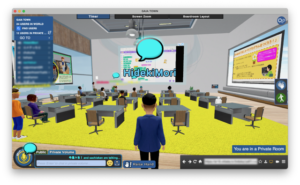
Scratch workshop was held in the Metaverse “MetaSupport Campus” operated by the Ehime Prefectural Board of Education. Except for the initial Zoom meeting with the teacher in charge, all meetings were held in the Metaverse. It reminded me of the meetings I had held in the past at schools and science museums, where I had to confirm the site before the meeting. The only difference is that since we are both avatars, it is strange to come back to myself. I am gradually getting used to it, and it feels more strange to talk face to face with the video on.
This was our first workshop, so we discussed what we could do in the metaverse space (GAIA TOWN), what tools we could use in the activities, and what kind of children would participate in the workshop with the teachers in charge.
Some of the participants had used Scratch before, while others had probably never used it before, and instead of participating directly as avatars, they participated as avatars at each of the 8 sites in the prefecture (behind one avatar, several children participated while using GIGA terminals). The workshop was full of challenges, such as the fact that the children were participating as avatars at each of the eight sites in the prefecture (behind one avatar, multiple children were participating using GIGA terminals), and the fact that the children’s expressions were not visible, even remotely.
After much consideration, we decided to focus on the theme of sound, and since this was our first workshop, we tried to create a greeting and chatting program using speech synthesis.
The workshop began quietly and timidly, but as each participant began his or her own activity, we could hear the sounds of the programs being created by the children at each site through the avatars. I could also hear how the sounds gradually evolved from squeals to rhythms and melodies. As is often the case in face-to-face workshops, when children begin to use sound or create programs that include sound, the classroom and venue often begin to connect through the medium of sound (and the organizers are relieved when they feel as if the children have been turned on).
Just before the workshop began, there was some trouble with my own screen not being able to be projected to the audience (probably my computer setup. I was not able to hear the sound of the children. I was not able to calm myself down as the workshop began, and I was finally able to calm down after hearing the children’s sounds.
I had felt this in previous face-to-face workshops, but this time I had the opportunity to reaffirm the power of sound in the workshop. I was able to feel the connection more than usual through the sounds of the children’s voices and the sounds from the activities, the facilitator’s voice, the participants’ laughter and surprise, and their confusion when things went wrong, the sounds of computer operations and objects that I vaguely heard, and the sounds that played outside each site. Perhaps I was trying to compensate for the inconvenience of not being able to see, without knowing it, by listening. I felt as if I was more sensitive to the children’s voices than usual, and I was able to feel the possibilities that inconvenience holds.
Nevertheless, we have many things to reflect on, including equipment problems, and there are many things we would like to try for the next time. In particular, I would like to try to see if it is possible to project the screen on the GIGA terminal that the children are using when explaining, or to do a live feed of my screen. This feeling of wanting to try this for the next time is also something I have not felt in a long time after a year and a half blank, and I am very excited about it.
I am very grateful to the Ehime Prefectural Board of Education for this precious opportunity, to the teachers who participated from various locations, and most of all to the more than 30 children who took part. Thank you very much. We are looking forward to the next Metaverse Workshop with seriousness and enjoyment.
Click here for the day’s materials(in Japanese).
